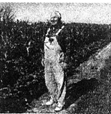题目内容
14."Clean your plate!"and"Be a member of the clean-plate-club!"Just about every kid in the US has heard this from a parent or grandparent.Often,it's accompanied by an appeal:"Just think about those starving orphans in Africa!"Sure,we should be grateful for every bite of food.Unfortunately,many people in the US take too many bites.Instead of staying"clean the plate",perhaps we should save some food for tomorrow.According to news reports,US restaurants are partly to blame for the growing bellies.A waiter puts a plate of food in front of each customer,with two to four times the amount recommended by the government,according to a USA Today story.Americans traditionally associate quantity with value and most restaurants try to give them that.They prefer to have customers complain about too much food rather than too little.
Barbara Rolls,a nutrition professor at Pennsylvania State University,told USA Today that restaurant portion sizes began to grow in the 1970s,the same time that the American waistline began to expand.
Health experts have tried to get many restaurants to serve smaller portions.Now,apparently,some customers are calling for this too.The restaurant industry trade magazine QSR reported last month that 57percent of more than 4,000people surveyed believe restaurants serve portions that are too large; 23percent had no opinion; 20percent disagreed.But a closer look at the survey indicates that many Americans who can't afford fine dining still prefer large portions.Seventy percent of those earning at least 150,000peryearprefersmallerportions;butonly45percentofthoseearninglessthan25,000want smaller.
It's not that working class Americans don't want to eat healthy.It's just that,after long hours at low-paying jobs,getting less on their plate hardly seems like a good deal.They live from paycheck to paycheck,happy to save a little money for next year's Christmas presents.
36.Parents in the United States tend to ask their childrenD.
A.to save food.
B.to wash the dishes.
C.not to eat too much
D.not to waste food.
37.Why do American restaurants serve large portions?B
A.Because Americans have big bellies.
B.Because Americans associate quantity with value.
C Because Americans are good eaters.
D.Because Americans are greedy.
38.What happened in the 1970s?C
A.The US government recommended the amount of food a restaurant gave to a customer.
B.Health experts persuaded restaurants to serve smaller portions.
C.The American waistline started to expand.
D.The United States produced more grain than needed.
39.What does the survey indicate?B
A.Twenty percent Americans want smaller portions.
B.Many poor Americans want large portions.
C.Fifty seven percent Americans earn 150,000peryear.
D.TwentythreepercentAmericansearnlessthan25,000per year.
40.Which of the following is Not true of working class Americans?D
A.They work long hours.
B.They live from paycheck to paycheck.
C.They want to save money for their children
D.They don't want to be healthy eaters.
分析 本文是一篇议论文.美国人在传统上把东西值不值跟数量联系在一起,20世纪70年代饭馆给的饭菜的量开始增加,与此同时,美国人的腰围也开始增大.美国工人也想做吃得健康的人.
解答 36.D 推理判断题.根据第一段"Clean your plate!"and"Be a member of the clean-plate club!"Just about every kid in the US heard this from a parent or grandparent.可知美国的父母倾向孩子不要浪费食物.故选D.
37.B 细节理解题.根据第二段Americans traditionally associate quantity with value and most restaurants try to give them that.They prefer to have customers complain about too much food rather than too little.可知美国人在传统上把东西值不值跟数量联系在一起,因此大多数的饭馆给的量大.这些饭馆乐于让顾客们抱怨饭菜给得太多而不乐于让他们抱怨饭菜给得太少.故选B.
38.C 细节理解题.根据第三段Barbara Rolls,a nutrition professor at Pennsylvania State University,told USA Today that restaurant portion sizes began to grow in the 1970s,the same time that the American waistline began to expand.可知一位宾州大学营养教授,Barbara Rolls,告诉《今日美国》20世纪70年代饭馆给的饭菜的量开始增加,与此同时,美国人的腰围也开始增大.故选C.
39.B 细节理解题.根据第四段only45percentofthoseearninglessthan25,000want smaller.可知只有45%的收入低于25000的人想要更小的部分.由此推知,许多贫穷的美国人想要大的部分.故选B.
40.D 细节理解题.根据最后一段It's not that working class Americans don't want to eat healthy.可知这不是工人阶级的美国人不想吃得健康.由此推知美国人想吃得健康.故选D.
点评 本文考察学生的理解推断能力以及细心程度,只要抓住文章的关键词,采用寻读的方法查找细节,就能找到正确答案.

-Not yet,but I .( )
| A. | expect so | B. | expect not | C. | don't expect | D. | expect to |
 The Green movement is catching on in many parts of the world.This is especially true in the construction industry.Today's buzz words,which include global warming and zero emissions,are causing people to look for ways to reduce their carbon footprints.Purchasing houses that are environmentally responsible is a good investment for those who are concerned about their own health and the well-being of the earth.Based on this trend,entire districts,known as eco-communities,are being designed with green initiatives in mind.Dockside Green in Victoria,British Columbia,Canada,is one of these communities.Its goal is to become the world's first zero emissions neighborhood.
The Green movement is catching on in many parts of the world.This is especially true in the construction industry.Today's buzz words,which include global warming and zero emissions,are causing people to look for ways to reduce their carbon footprints.Purchasing houses that are environmentally responsible is a good investment for those who are concerned about their own health and the well-being of the earth.Based on this trend,entire districts,known as eco-communities,are being designed with green initiatives in mind.Dockside Green in Victoria,British Columbia,Canada,is one of these communities.Its goal is to become the world's first zero emissions neighborhood. In the Central Valley of California,farmers are reducing crop size because they do not have enough water.Last year,California had the least amount of rain since officials began keeping records.And it may be just as bad this year.
In the Central Valley of California,farmers are reducing crop size because they do not have enough water.Last year,California had the least amount of rain since officials began keeping records.And it may be just as bad this year.